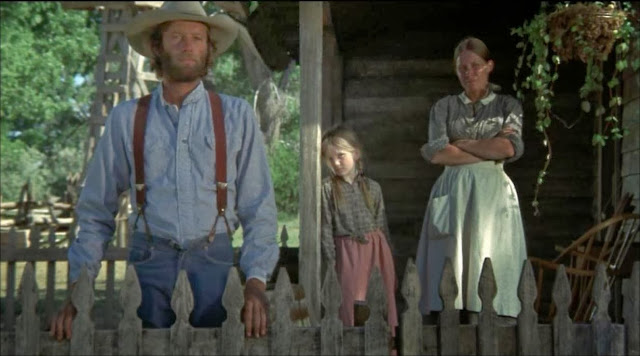Acid Westerns: The Hired Hand (1971)
"The Hired Hand" often gets lumped in on lists of Acid Westerns, but I'm not convinced it belongs, unless we stretch the definition pf Acid Western to mean "any Western with a hint of hippie to it." There is a folksy, earthy, bearded-men-doing-rural-labor quality to the film for a little while, and it would be possible to pull these images, claim they were from hippies working on a commune, and nobody would be any the wiser.
Other than that, the film is a plaintive, meditative Western with a near-perfect three act structure: In the first, three cowboys, including director Peter Fonda and Warren Oates, get bushwhacked in a mean little town. One from the group gets killed, so they take their revenge. In the second act, Fonda, sick of the peripatetic life of a cowboy, returns to a wife and daughter he abandoned, Oates in tow, and works his way back into her good graces. In the third act, Oates is kidnapped by the bushwhackers, and Fonda goes to rescue him.
It's no wonder the script is as well-fashioned as it is. The script was by Alan Sharp, one of the finest screenwriters to emerge during the 60s and 70s, responsible for "Night Moves," a highly regarded thriller from Arthur Penn, and "Rob Roy," the extraordinary Liam Neeson historical drama. Sharp also wrote "Ulzana's Raid," another film frequently classified as an Acid Western, and one we address elsewhere.
Aside from the script's tidy structure, it's a small but very fine portrait of life on the frontier. The cowboys have a very close friendship, but are also desperately lonely. Fonda's wife, played with startling frankness by Verna Bloom, is distrustful — she's unconvinced Fonda won't leave again, and uncertain his friendship with Oates doesn't take priority over her marriage with Fonda. There are a lot of scenes of them sitting on a porch, just hashing it out, and that's not the sort of thing you typically see in a Western.
She is right to be untrusting, by the way. She senses that there is terrible heartbreak ahead with these two men, and the film's final cinematic beat is watching her heart quietly break.
I will note that the film seems to subtly mount a defense for free love, which, I suppose, also brings up the specter of the hippie. It comes out that Bloom has a long history of taking her hired hands on as lovers, which initially outrageous Fonda, and he receives a stern lecture for it from her. Moreover, the film's plot makes the case that this is an approach to romance that is emotionally safer for Bloom. Monogamy, it turns out, is a bummer.
If "The Hired Hand" is just barely an Acid Western in execution, it's undeniably a kin to the genre. It was produced in the same circumstances that produced Dennis Hopper's "The Last Movie": After the success of "Easy Rider," Fonda and Hopper were each given $1 million by the studios and went off to direct a Western. In both instances, the Westerns were critical and box office disappointments, although "The Hired Hand" didn't receive the critical drubbing Hopper got.
Watching it now, it's not clear why "The Hired Hand" wasn't appreciated more when it came out. Hopper's film is a dazzling mess, but "The Hired Hand" is a surprisingly assured and mature piece of film-making for a first-time director. The film was magnificently lensed by Vilmos Zsigmond and features a series of elegiac montages by editor Frank Mazzola, as well as a haunting folk-tinged score by Bruce Langhorne, all of whom are well-regarded in their fields. (Langhorne, for readers who are unfamiliar, was a fixture on the East Village folk scene and the inspiration for Bob Dylan's "Mister Tambourine Man.")
Additionally, the film greatly benefits from the revisionist tendencies of Westerns of the era. It often doesn't look like earlier Westerns. The border town in the first act, as an example, is a ramshackle place with exposed beams, looking less like the classic Western backlot and more like the village of Sweethaven from the live-action "Popeye," which itself resembled a town assembled from scrap wood. The cowboys are filthy, have scruffy beards and wear weird, battered hats with high, round domes, like Tom Mix fell in the mud and stayed there for several years.
If I had to guess why the film didn't find much critical or audience support, I would guess that in 1971, maybe people were a little sick of hippies. Even in Westerns. Even when they are only hinted at.



Comments
Post a Comment